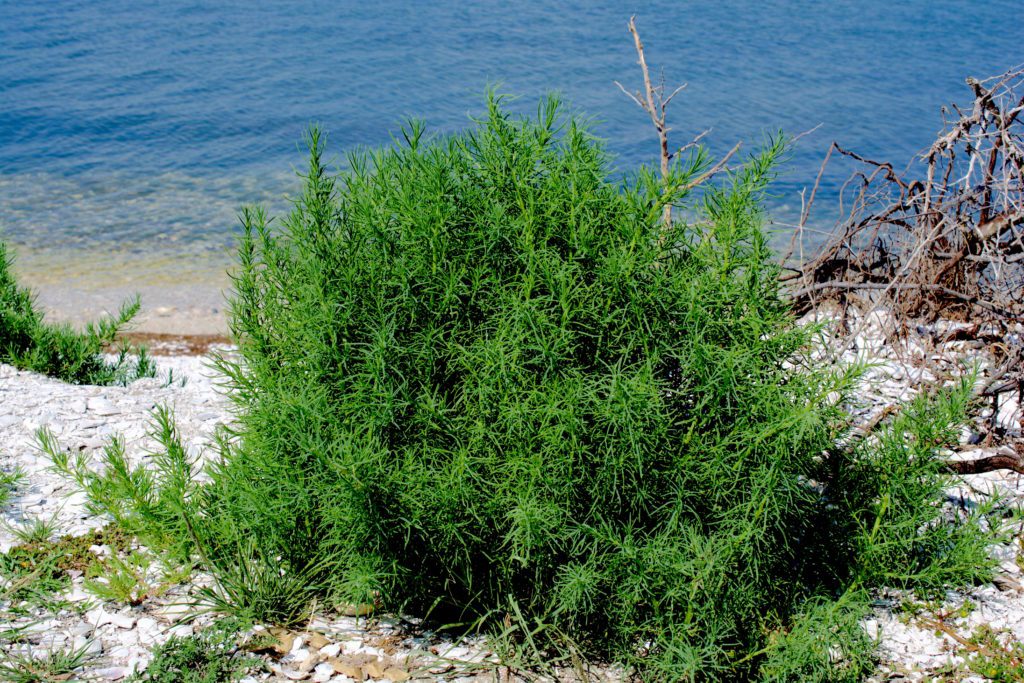
Seablite is my candidate to be a new commercial vegetable. Photo by Green Deane
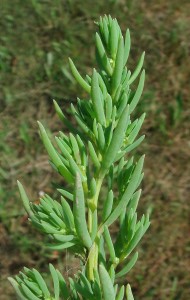
Seablite is related to Lamb’s Quarters. Photo by Green Deane
For foragers on the coast Suaeda linearis is in season from Daytona Beach to Port Charlotte, not on the beach side but the intracoastal water ways, river-fed harbors, and brackish water. It’s a great spring time green that has everything going for it except perhaps its name, Seablite. The plant is mild but tasty, has excellent texture, can be eaten raw or cooked though cooked is the usual way. It makes an excellent stuffing when roasting or poaching fish. Seablite is nutritious, stores well, looks good, grows easily in salty ground (read unused land) and even feels good to handle. You can also cultivate it in your garden, far from the sea. It would make an excellent commercial product, perhaps better than other wild foods brought to market. Think of Seablite as a Chinopodium that likes to grow in salty places, either near the ocean or salt licks. It has a high sodium content but boiling reduces that significantly. If you live anywhere near the ocean look for it. If you live inland near salt deposits look for its edible cousin, seepweed.
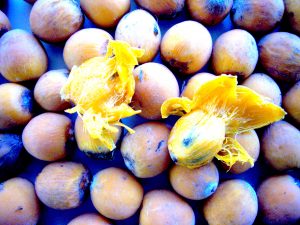
Queen Palm Fruit Are Tasty.
Another nice species starting its long season is Queen Palm (Syagrus romanzoffiana.) A tall and stately ornamental, Queen Palm fruit start out green then turn to light orange then dark orange and then fall to the ground. They are very sweet and gooey with a large edible seed (the seed oil is edible, too.) The fruit is kind of like eating sugary paste with some fiber tossed in. The fruit can be made into jelly and wine though the latter won’t clear because of the high pectin content. (Pindo palm [Butia capitata] fruit are also edible. Those palms are short and squat with yellow fruit.) Interestingly the two palm can hybridize.
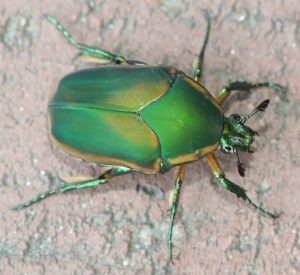
June Bugs are edible but it might be wise to change their diet first.
Despite my website’s title, Eat The Weeds And Other Things, Too, YUCK! is word that lands in my mailbox regularly, sprinkled through the missives like spice on an entree. It reminds me of what a great language English is. English is not some frou-frou glot of genteel nuances or unique sounds. And while it might have started out as German Lite English has borrowed so much from other languages that it’s the largest and most predominate tongue on Earth. But beyond that English is fit. It’s muscular, punchy, to the point. English has brawn. It works out, demands attention, and gets things done. Yelling EXTINGUISH THE CONFLAGRATION will stir few to action. PUT OUT THE FIRE will. Latin just can’t hold a candelabra to English.
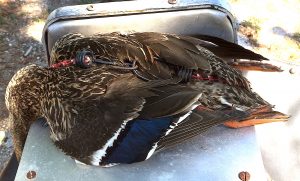
Hit by a car, taken home on a motorcycle, aged in the frig.
So yes, “yuck,” a taut, vigorous English word populates my emails. Why? The answer is the Acorn Grub video, the Bon Appetit video, articles on the edibility of dogs and cats, Guinea pigs, horses, alligator, armadillos, slugs and snails, earthworms, scorpions, spiders and some four dozen other insects such as the June Bug above. I know of a naturalist who starts each class on wild edibles by eating a live beetle he finds in front of everyone. To him all black beetles are edible. “Yuck” you say. Perhaps. So powerful is that one word that several folks have sent just one word emails to me… Yuck is succinct. It tells me the writer’s mental state and their opinion, which is fine. In matters of taste there is no debate: Only matters of truth are worthy of debate. And just as some find these critters “yucky” so to do many find eating weeds “yucky.” I hear from them, also. Som did not like a recent mention of me cooking a duck hit by a car. “Yuck” was the response of choice but the duck was not yucky… I guarantee. It was just ducky.
 There’s a quaint British detective series which involves an obese chef who is also a senior police detective. (Only the Brits can get away with funding and producing such a show theme.) In one program the main character’s job is to help protect and feed a rather nasty young woman who is to testify against her deadly husband. At the same time the detective-chef is having a difficult time getting quality herbs for his restaurant. The “safe” house where she is staying just happens to have fantastic herbs just growing out back which he discovers. There’s a wonderful exchange about wild food between the avuncular detective-chef and one of the young armed officers protecting the woman. It’s an attitude most of us foragers have seen before. To see the 42-second clip click here.
There’s a quaint British detective series which involves an obese chef who is also a senior police detective. (Only the Brits can get away with funding and producing such a show theme.) In one program the main character’s job is to help protect and feed a rather nasty young woman who is to testify against her deadly husband. At the same time the detective-chef is having a difficult time getting quality herbs for his restaurant. The “safe” house where she is staying just happens to have fantastic herbs just growing out back which he discovers. There’s a wonderful exchange about wild food between the avuncular detective-chef and one of the young armed officers protecting the woman. It’s an attitude most of us foragers have seen before. To see the 42-second clip click here.
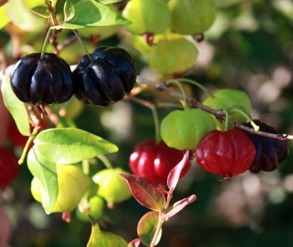
Surinam Cherries have eight ribs. There are red and deep purple varieties. Photo by Green Deane
Out of season plants can be dangerous. This past weekend during a foraging class I was stung by a stinging nettle, an Urtica. That is worthy of mention for a couple of reasons: One, nettles locally are usually a December to February find, rarely in March, never in April. But we did find a few plants and one did sting me. And two, I have, unfortunately, an extreme reaction to them. Our local species, the Heartleaf Nettle, is the second-worst nettle sting on earth. I won’t say it makes me suffer but on the pain scale it approaches that. A kidney stone is worse, that is true suffering. But my reaction to the local nettle is on the same painful highway just not as far down the road. More surprising this weekend was to see true chickweed. That has an even shorter season that nettles, perhaps two months at the most, a December-January species. We found two patches of it on tax day. Very unusual. Pellitory has also been expanding its season and we found a lot though it is a month well-passed its common sighting. One can always find a little in deep shade into late spring but it is still prolific in some places. On the other side grapes seem to be setting early this year. Whether that will lead to an early harvest or sweeter grapes than usual we will just have to wait and see. Mulberries also seemed early this year as are Suriname Cherries. I have found some almost ripe, in the shade, mid-state. Tallow Plums seem to be behind season. I have picked them in April in the past but this year many of them haven’t even blossomed yet.
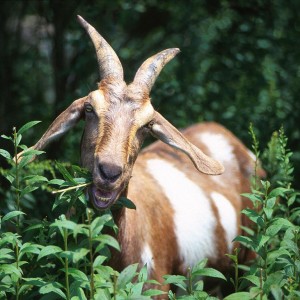
Goat on the lam…
Let’s say you were going to take a test. And you knew out of 100 possible questions only seven questions were going to be asked and only those seven. Which would you study for, the 93 questions that will not be asked or the seven that will be asked? One would expect you to study the seven questions you know are going to be asked. It is no different when learning edible wild plants. About 93 percent of the plants are not edible. Around seven percent are (generous estimates say 10% but it varies with geography.) Which should you study if you are interested in edible wild plants? The seven percent that are edible or the 93 percent that are not? Most folks interested in edible wild plants go about it backwards. They don’t go looking for known edibles but wonder what all unknown plants are. Then they ask someone to identify them. More than nine times out of ten it is not edible. Looking for known edibles is far more productive. But if you still have a plant you want identified, post it on the Green Deane Forum. We have a board dedicated to just identifying plants, which is also the most popular board. You can join the forum by clicking on the FORUM button in the menu line.

Green Deane DVD Set
Spring orders have started their annual increase. All of Green Deane’s videos available for free on You Tube. They do have ads on them so every time you watch a Green Deane video I get a quarter of one cent. Four views, one cent. Not exactly a large money-maker but it helps pays for this newsletter. If you want to see the videos without ads and some in slightly better quality you can order the DVD set. It is nine DVDs with 15 videos on each. Many people want their own copy of the videos or they have a slow service and its easier to order then to watch them on-line. They make a good gift for that forager you know. Individual DVDs can also be ordered. You can order them by clicking on the button on the top right of this page or you can go here.

Foraging classes are held rain, shine, hot or cold. Photo by Nermina Krenata
Foraging Classes: This week they ranged from Orlando to Sarasota and managed to dodge a nasty storm front. Only one public class this weekend and that’s in Port Orange. There we will see four or five salt tolerant plants and if the Bird-Gods are generous some fruiting local Goji Berries.
Sunday, April 22nd, Spruce Creek, 6250 Ridgewood Ave. Port Orange, 32127, 9 a.m., meet at the pavilion.
Saturday, May 5th, Florida State College, south campus, 11901 Beach Blvd., Jacksonville, 32246. 9 a.m. We will meet at building “D” next to the administration parking lot.
Sunday, May 6th, Wickham Park, 2500 Parkway Drive, Melbourne, FL 32935-2335. Meet at the “dog park” inside the park, 9 a.m.
Saturday, May 12th, Blanchard Park, 10501 Jay Blanchard Trail, Orlando, FL 32817. 9 a.m. Meet at the pavilion east of the tennis courts near the YMCA.
Sunday, May 13th, Bayshore Live Oak Park, Bayshore Drive. Port Charlotte, FL, 9 a.m. Meet at the parking lot across from Ganyard Street.
Saturday May 19th, Eagle Park Lake, 1800 Keene Road, Largo, FL 33771. 9 a.m. Meet at the pavilion near the dog park.
Saturday, May 26th, George LeStrange Preserve, 4911 Ralls Road, Fort Pierce, FL, 34981. 9 a.m.
Sunday May 27th, Dreher Park, 1200 Southern Blvd., West Palm Beach, 33405. 9 a.m. just north of the science center.
Saturday, June 2nd, Red Bug Slough Preserve, 5200 Beneva Road, Sarasota, FL, 34233, 9 a.m.
Sunday June 3rd, Colby-Alderman Park: 1099 Massachusetts Street, Cassadaga. Fla. 9 a.m., meet near the restrooms.
Saturday, June 9th, Blanchard Park, 10501 Jay Blanchard Trail, Orlando, FL 32817. 9 a.m. Meet at the pavilion east of the tennis courts near the YMCA.
Sunday, June 10th, Boulware Springs Park, 3420 SE 15th St., Gainesville, FL 32641. Meet at the picnic tables next to the pump house, 9 a.m.
To learn more about Green Deane’s foraging classes go here.
If you have an interest in mushrooms the Orlando Mushroom Group will have a fungal foray May 20th in Lake Mary, Florida. Cost is $10 per adult. Offering his expertise is Joshua Buchanan. You can get more information by visiting the Facebook page of the Orlando Mushroom Group or email me.
 This is newsletter issue 300. A quick calculation would suggest some six year’s worth of newsletter but it’s longer than that. The first few years the newsletter was monthly not weekly. This was primarily because of emailing difficulties. I maintained my own mailing list and the newsletter had to be sent to out a few at at time because one wrong email would send them all back. Then MAC decided to abandon the server business. This lead to a new site, news server and a mailing company which charges me $75 a month to mail four newsletters. Hurricane Irma also factors into the newsletter. When the site was down because of the hurricane class attendance dropped significantly. Facebook was a poor substitute for letting folks know about the foraging classes. So despite the cost the newsletter serves several purposes. One is to let folks know what we are currently foraging, what’s in season, and if it is different than usual. For example, two very cold weeks we had more than a month ago might be responsible for several species still in season when they usually would have been long gone by now. When I was a working journalist on a daily newspaper we had to write a weekly column. It was a chore because one had to find something every week to write about. This weekly newsletter has not been a chore because there is always something to write about. It is work, but it is also fun and keeps both of us informed. (One of the first weekly newsletters is below. The monthly ones are buried on some CD.)
This is newsletter issue 300. A quick calculation would suggest some six year’s worth of newsletter but it’s longer than that. The first few years the newsletter was monthly not weekly. This was primarily because of emailing difficulties. I maintained my own mailing list and the newsletter had to be sent to out a few at at time because one wrong email would send them all back. Then MAC decided to abandon the server business. This lead to a new site, news server and a mailing company which charges me $75 a month to mail four newsletters. Hurricane Irma also factors into the newsletter. When the site was down because of the hurricane class attendance dropped significantly. Facebook was a poor substitute for letting folks know about the foraging classes. So despite the cost the newsletter serves several purposes. One is to let folks know what we are currently foraging, what’s in season, and if it is different than usual. For example, two very cold weeks we had more than a month ago might be responsible for several species still in season when they usually would have been long gone by now. When I was a working journalist on a daily newspaper we had to write a weekly column. It was a chore because one had to find something every week to write about. This weekly newsletter has not been a chore because there is always something to write about. It is work, but it is also fun and keeps both of us informed. (One of the first weekly newsletters is below. The monthly ones are buried on some CD.)
Newsletter 1 June 2010
WHY FORAGE?
Often I am asked “why forage for wild food?” Why that question is asked is probably worthy of an article unto itself. But here let’s focus on one answer (out of several.) Let’s look at cost.
The U.S. Bureau of Labor Statistics released recently their March (2010) number crunching. Food prices in March rose 2.4%, the sixth month in a row food prices have gone up, and the largest jump since 1984. But that’s counting everything. If you look at specific categories the numbers are more revealing.
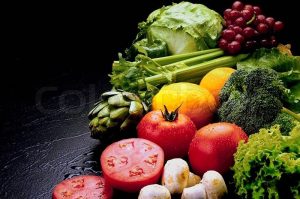 Fresh and dry vegetables went up up 56.1%, fresh fruits and melons 28.8%, fresh eggs 33.6%, pork 19.1%, beef and veal up 10.7% and dairy products up 9.7%. All of that makes the Bidens pilosa growing in my yard all the more attractive, maybe even that pesky squirrel. Some think “food inflation” will continue even if the economy improves. Apparently that is what is happening in India now. Some investment gurus are talking about investing in, literally, food, and others like Warren Buffet are recommending investiment in agriculture or countries with a lot of agriculture.
Fresh and dry vegetables went up up 56.1%, fresh fruits and melons 28.8%, fresh eggs 33.6%, pork 19.1%, beef and veal up 10.7% and dairy products up 9.7%. All of that makes the Bidens pilosa growing in my yard all the more attractive, maybe even that pesky squirrel. Some think “food inflation” will continue even if the economy improves. Apparently that is what is happening in India now. Some investment gurus are talking about investing in, literally, food, and others like Warren Buffet are recommending investiment in agriculture or countries with a lot of agriculture.
It’s interesting the price of plant products rose more than animal products, though animal products are also dependent on plants, however not necessarily plants that man grows. The difference is commercial plants for people need chemicals and tending whereas many plants for animals — range grass for example — do not nor do most of the weeds we eat. However, contrary to what most folks think foraging is not free. There are costs. Discounting time, one has to get to a place to forage. One has to transport the collected food and the food has to be cleaned. That requires some cost, from calories to bike tires to gasoline to clean water.
 One also needs to know which plants to pick. That knowledge can come free, and/or from lessons, books, and internet services. My personal plant library of some 128 books cost me about $2,500. You may never own more than one foraging book but my point is wild food is not totally free. But, it is the next thing to free, and the cost a lot less than store-bought food and is less subject to inflation and taxes. Once you have foraging knowledge inside your head any cost gets prorated over time to the point of being negligible. A $30 course and a $20 book totals up to $50 but if you and yours can eat for a lifetime it’s a good investment. It’s also a certain measure of independence and security. I’m not suggesting foraging an answer to the growing food problem. With unemployment hovering near 17% (depending who’s counting and how they count) there are nearly 40 million Americans on food stamps, up 22.4% over this time last year. The government is now paying out more in benefits than it is taking in. At some point entitlement programs will be cut back. However, 40 million people can’t go out and forage even if they knew how. The impact on the environment would be devastating. The realty is not even one percent of them (400,000) are interested in foraging. I doubt that even one tenth of one percent (40,000) are interested. Maybe one hundredth of one percent might be interested, 4,000, which is close to my number of subscribers. See how uncommon you are?
One also needs to know which plants to pick. That knowledge can come free, and/or from lessons, books, and internet services. My personal plant library of some 128 books cost me about $2,500. You may never own more than one foraging book but my point is wild food is not totally free. But, it is the next thing to free, and the cost a lot less than store-bought food and is less subject to inflation and taxes. Once you have foraging knowledge inside your head any cost gets prorated over time to the point of being negligible. A $30 course and a $20 book totals up to $50 but if you and yours can eat for a lifetime it’s a good investment. It’s also a certain measure of independence and security. I’m not suggesting foraging an answer to the growing food problem. With unemployment hovering near 17% (depending who’s counting and how they count) there are nearly 40 million Americans on food stamps, up 22.4% over this time last year. The government is now paying out more in benefits than it is taking in. At some point entitlement programs will be cut back. However, 40 million people can’t go out and forage even if they knew how. The impact on the environment would be devastating. The realty is not even one percent of them (400,000) are interested in foraging. I doubt that even one tenth of one percent (40,000) are interested. Maybe one hundredth of one percent might be interested, 4,000, which is close to my number of subscribers. See how uncommon you are?
 This we know: Food prices are rising, sharply. There is some cost associated with learning how to forage, and most people are not interested in foraging — at least not now. I think that adds up to a strong argument that not only is it economical to forage but that it will be a steady food supply because others don’t see the value it represents, and even if they did they are far behind you in the learning curve. Learning to forage can mean you have something to eat when they don’t. You certainly have more variety and better nutrition. When you learn to forage you are doing more than identifying edible wild plants. You are also developing a skill and confidence. No matter how dire the need, those cannot be learned overnight. Foraging is like rigging, you learn mostly by doing and that cannot be rushed. You’re already way ahead of millions.
This we know: Food prices are rising, sharply. There is some cost associated with learning how to forage, and most people are not interested in foraging — at least not now. I think that adds up to a strong argument that not only is it economical to forage but that it will be a steady food supply because others don’t see the value it represents, and even if they did they are far behind you in the learning curve. Learning to forage can mean you have something to eat when they don’t. You certainly have more variety and better nutrition. When you learn to forage you are doing more than identifying edible wild plants. You are also developing a skill and confidence. No matter how dire the need, those cannot be learned overnight. Foraging is like rigging, you learn mostly by doing and that cannot be rushed. You’re already way ahead of millions.
A NEW VEGETABLE
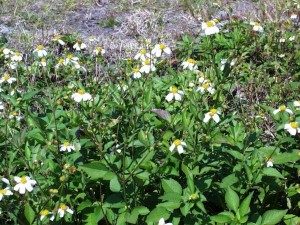
Bidens alba
If you could choose one wild plant to become a commercial product, what would it be? Many people have tried to make poke weed (Phytolacca americana) a green in your local grocery but toxicity and the required two-boilings has always plagued its commercialization. The ground nut (Apios americana) was one of the original exports from colonial America but it has at least a two-year growth cycle. Louisiana State University (1984-96) developed a commercial variety but the program disappeared when the professor-in-charge, Bill Blackmon, changed colleges. In 1962 Professor Julia Morton of the University of Miami recommended Spanish Needles (Bidens pilosa) become a commercial product. Nearly a half a century later that hasn’t happened, perhaps because of flavor or the fact it can grow almost anywhere as a weed. My candidate would be Suaeda linearis, Sea Blite, and if I could figure out how to do it I would.
HOW SAFE IS FORAGING?
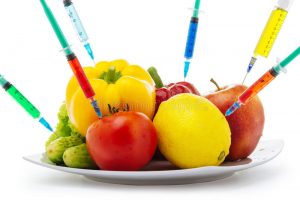 Excluding mushroom hunters, plant foragers have a good track record of staying alive. Plant foragers have about one accidental death every 20 years, and usually that’s from eating some member of the poison hemlock crowd. That should be a word to the wise. Locally, the nemesis is the water hemlock and it grows exactly where watercress grows. When I collect watercress I look at every piece before I collect or cook it, every single piece. Actually, there are several deadly local plants: Water hemlock, the Yew, Oleander, Castor Beans, and the Rosary Pea, the most toxic seed on earth. I have been asked to do a video on toxic plants but I am afraid some idiot will not understand what the video is about and eat the wrong plant. Most plant poisonings involve toddlers eating from the landscaping (toxic ornamentals) around their home, with the next highest incidence is toddlers eating the landscaping from their neighbor’s yard. Why we fill our home space with toxic plants rather than edible landscaping is beyond me. Excluding suicides, adult poisonings are extremely rare. So, don’t be afraid of foraging. Just be careful. Study. Take lessons. Go with a friend. ITEMize!
Excluding mushroom hunters, plant foragers have a good track record of staying alive. Plant foragers have about one accidental death every 20 years, and usually that’s from eating some member of the poison hemlock crowd. That should be a word to the wise. Locally, the nemesis is the water hemlock and it grows exactly where watercress grows. When I collect watercress I look at every piece before I collect or cook it, every single piece. Actually, there are several deadly local plants: Water hemlock, the Yew, Oleander, Castor Beans, and the Rosary Pea, the most toxic seed on earth. I have been asked to do a video on toxic plants but I am afraid some idiot will not understand what the video is about and eat the wrong plant. Most plant poisonings involve toddlers eating from the landscaping (toxic ornamentals) around their home, with the next highest incidence is toddlers eating the landscaping from their neighbor’s yard. Why we fill our home space with toxic plants rather than edible landscaping is beyond me. Excluding suicides, adult poisonings are extremely rare. So, don’t be afraid of foraging. Just be careful. Study. Take lessons. Go with a friend. ITEMize!
CAN A FORAGER FIND TRUE LOVE?
 According to the Timberland Company they can. The New Hampshire-based outfitting company has released the results of their 2010 eco-love survey. Oddly, it was male-centric. Apparently men are looking for love in all the green places. (Don’t shoot this messenger.) Must Love the Earth. Fifty-four percent of men would question whether to start a relationship with a woman someone who litters. Others would ponder if a woman was worth dating if she doesn’t recycle (25%), leaves the lights on when not at home (23%) or drives a gas-guzzler (21%). Guys Dig Green. One-quarter of men think “green” women make better life partners (24%) or friends (27%) than those who aren’t so environmentally responsible. Plan an Eco-date. 41% of men would be more interested in an “adventure” date like hiking or rock climbing or a charity or service-focused date like tree planting, rather than the traditional “dinner and a movie” date. Green eco-lebrities. Men say Cameron Diaz (27%) and Kate Hudson (26%) would inspire them to go green. Feelings are mixed on eco-celeb Jessica Biel. Twenty-one percent of men say she’s an inspiring green celeb, but only 13 percent of women agree. Going Green. Almost a third of Americans (30%) feel they need to make more of an effort to purchase eco-friendly clothing over the next year. And, before you set out on your eco-date, consider eating locally grown food. More than half (53%) of Americans think that eating locally grown foods should be a priority in the next year. Almost three-quarters (72%) think Americans need to switch to energy-efficient light bulbs, 57 percent think Americans need to green their daily commutes by carpooling, walking or biking to work and 47 percent want others to take showers instead of baths to save water (showering with someone even saves more water.)
According to the Timberland Company they can. The New Hampshire-based outfitting company has released the results of their 2010 eco-love survey. Oddly, it was male-centric. Apparently men are looking for love in all the green places. (Don’t shoot this messenger.) Must Love the Earth. Fifty-four percent of men would question whether to start a relationship with a woman someone who litters. Others would ponder if a woman was worth dating if she doesn’t recycle (25%), leaves the lights on when not at home (23%) or drives a gas-guzzler (21%). Guys Dig Green. One-quarter of men think “green” women make better life partners (24%) or friends (27%) than those who aren’t so environmentally responsible. Plan an Eco-date. 41% of men would be more interested in an “adventure” date like hiking or rock climbing or a charity or service-focused date like tree planting, rather than the traditional “dinner and a movie” date. Green eco-lebrities. Men say Cameron Diaz (27%) and Kate Hudson (26%) would inspire them to go green. Feelings are mixed on eco-celeb Jessica Biel. Twenty-one percent of men say she’s an inspiring green celeb, but only 13 percent of women agree. Going Green. Almost a third of Americans (30%) feel they need to make more of an effort to purchase eco-friendly clothing over the next year. And, before you set out on your eco-date, consider eating locally grown food. More than half (53%) of Americans think that eating locally grown foods should be a priority in the next year. Almost three-quarters (72%) think Americans need to switch to energy-efficient light bulbs, 57 percent think Americans need to green their daily commutes by carpooling, walking or biking to work and 47 percent want others to take showers instead of baths to save water (showering with someone even saves more water.)
SALT SELLER
 There’s less salt in your future but not less salt flavor, so it is claimed. PepsiCO did some research and found that only 20% of the salt on their products contributed to taste whereas 80% got swallowed undissolved, read untasted. So the company successfully set out to reshape salt crystals to melted faster on the tongue thus giving the same salty flavor but using 25% less salt. That would clearly cut costs for them in the future but the question is how will that be positioned on the label? 25% LESS SALT! LESS SALT MORE FLAVOR! Heck they might make an extra salty tasting product but claim it has normal salt levels. Quite a few possibilities. The new salt needs no approval, says PepsiCo, because it is just reshaped salt.
There’s less salt in your future but not less salt flavor, so it is claimed. PepsiCO did some research and found that only 20% of the salt on their products contributed to taste whereas 80% got swallowed undissolved, read untasted. So the company successfully set out to reshape salt crystals to melted faster on the tongue thus giving the same salty flavor but using 25% less salt. That would clearly cut costs for them in the future but the question is how will that be positioned on the label? 25% LESS SALT! LESS SALT MORE FLAVOR! Heck they might make an extra salty tasting product but claim it has normal salt levels. Quite a few possibilities. The new salt needs no approval, says PepsiCo, because it is just reshaped salt.
SPROUTS
The Weeping Holly (Ilex vomitoria “pendula”) has more caffein in its leaves than any plant in North America.
 Donations to upgrade EatTheWeeds.com and fund a book are going well. Thank you to all who have contributed to either via the Go Fund Me link, the PayPal donation link or by writing to Green Deane POB 941793 Maitland FL, 32794. Recent upgrades have been paid now the Forum needs work and several function problems need to be fixed specifically the search and categories. A new server also being considered. The other issue is finding an indexing program or function for a real book. Writing programs used to do it automatically if you designated a term for indexing. Now that most books are ebooks most writing programs do not provide and indexing function.
Donations to upgrade EatTheWeeds.com and fund a book are going well. Thank you to all who have contributed to either via the Go Fund Me link, the PayPal donation link or by writing to Green Deane POB 941793 Maitland FL, 32794. Recent upgrades have been paid now the Forum needs work and several function problems need to be fixed specifically the search and categories. A new server also being considered. The other issue is finding an indexing program or function for a real book. Writing programs used to do it automatically if you designated a term for indexing. Now that most books are ebooks most writing programs do not provide and indexing function.
This is weekly issue 300.
If you would like to donate to Eat The Weeds please click here.


Firstly, congratulation on the occasion of the 300th. issue of the lovely Eattheweeds . I hope for more progress and advancement in future . Secondly, I agree there is considerable need for foraging education especially for people like mine – Sudan – where food price is high due to inflation as a result of high taxation and un emploment . As suggestd before , I include Purslane as the commercil food . Thirdly , English langauge is leading if not for intrusion of almost every day new words – vocabulary – for which I can’t trace the meaning in any modern dictionary. Consider watching e.g. CNN Tv .channel .
seablite was sold as a native food at something wild, a permanent stall at the Adelaide farmers market in south Australia. they also sold several other indigenous forage foods and I tried all of them. seablite tasted and felt like asparagus and I think it was called sea asparagus on the label